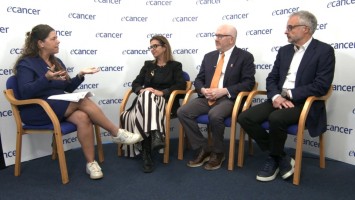PARP inhibitors have made a big impression in the management of recurrent ovarian cancer but you also heard that when patients have a recurrence eventually that becomes a fatal disease and although we can extend survival or extend the time the disease is controlled, they will die of their disease. So the real aim of our treatment now needs to be very much focussed on preventing that first recurrence which occurs in 70% of patients. Actually if you look back at all the trials that have been done and the drugs that have been developed over the last few years we’ve actually made very little impression on the first line treatment of women with ovarian cancer. There are still 70% of these women will have a recurrence.
So the opportunity to bring a PARP inhibitor into the first line setting was a very interesting opportunity, particularly in women with a BRCA mutation. We know that the PARP inhibitors are more effective in patients who carry a BRCA mutation; although they will work in many other groups of patients they are most effective in those with a BRCA mutation. So this was the best group to select the testing of a PARP inhibitor in that first line setting.
The data that you saw showed actually very robust progression free survival data because the analysis was done when all the patients had been followed for a minimum of three years, having stopped the PARP inhibitor at 24 months which was the planned time to stop. If you looked at those curves, and as Dr Moore pointed out, actually the shape of the curves did not change beyond two years. So it does not seem as though the curves are coming together after the treatment has been stopped. Now, that’s a very, very interesting result. Of course we’re going to have to wait until the overall survival data mature, that I think will be a long time because these patients with a BRCA mutation often survive for long periods of time. But we haven’t even seen the median progression free survival being reached yet, which again is very encouraging. Comparing that with all the trials we’ve done with other cytotoxic chemotherapy and drugs like bevacizumab we’ve just not seen median progression free survivals that good at that period of time out to three years.
So there’s a real hope that this treatment will perhaps lead to an increase in the cure rate which will be reflected by a reduction in the first relapse rate. We’ll need to wait longer for that but there’s no doubt that this is a big step forward for the patients with BRCA mutated ovarian cancer. There are many challenges, not least the access to the drug and the cost of the drug, but also the testing of patients for a BRCA mutation. That has improved over the last few years as PARP inhibitors have become more widely available but we will need to get that testing done earlier in patients at diagnosis to know whether they will be able to qualify for olaparib maintenance after the end of their first chemotherapy. That produces some logistical challenges in many countries and many regions but overall it’s a very big step forward and very much a landmark trial for the treatment of patients with ovarian cancer.
